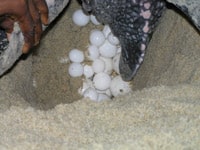Some populations of leatherback sea turtles are growing.
Click image to enlarge The number of endangered leatherback sea turtle nests at 68 beaches in Florida has increased. |
The number of endangered leatherback sea turtle nests at 68 beaches in Florida has increased by 10.2 percent a year overall since 1979, according to a new Duke University-led study. Some of the beaches surveyed posted annual increases of leatherback sea turtles of more than 16 percent, whereas in other cases, the growth was just 3.1 percent.
This population boom of leatherback sea turtle nests in Florida mirrors trends observed for other Atlantic leatherback sea turtle populations and is "very encouraging news," according to Larry B. Crowder, director of the Duke Center for Marine Conservation. “It suggests that conservation and recovery efforts mandated under the Endangered Species Act are paying off region-wide.”
Factors Involved
Crowder said that the leatherback sea turtle population growth has likely been fueled in part by improved monitoring and protection of nesting beaches over the last 30 years, but other less benign factors may also be at work.
“Nesting is increasing even where beach protection has not been enhanced,” Crowder said. “Changing ocean conditions linked to climate variability may be altering the marine food web and creating an environment that favors turtles by reducing the number of predators and increasing the abundance of prey, particularly jellyfish.”
“With plenty of jellyfish to munch on, breeding-age female leatherbacks may be able to build up fat reserves more quickly, allowing them to nest more frequently,” said Kelly Stewart, lead author of the study.
Stewart said that she thinks reduced populations of large predators, including the collapse of shark populations in the northwest Atlantic over the past decade, may be playing an even larger role in the turtle boom by decreasing at-sea mortality rates for juvenile and young adult leatherback sea turtles.
Despite being a small population – scientists estimate fewer than 1,000 leatherback sea turtles nest on Florida’s beaches – the increase in nest counts may help achieve objectives of the federal Endangered Species Act-mandated recovery plan, according to Stewart.
Better Understanding
News for leatherback sea turtle populations elsewhere is not so encouraging, however. Leatherback sea turtle populations have plummeted at eastern Pacific nesting beaches in Mexico and Costa Rica, which once hosted thousands of female leatherback sea turtles each year. Extirpation of the species (meaning local extinction) may be imminent on those nesting beaches.
“The good news is that while most sea turtle populations continue to decline, some are growing in numbers,” Crowder said. “We need to understand why they are increasing as much as why others are declining, so we can transfer this understanding to other at-risk marine turtles, like Pacific leatherbacks.”
Stewart, Crowder and their colleagues modeled the 30-year leatherback sea turtle nest counts on Florida beaches using a type of multilevel statistical analysis called Poisson regression, which is frequently used to model numbers affected by multiple, often random, factors. Nest counts are the most reliable way of assessing trends in sea turtle populations because these reptiles spend most of their lives roaming the open ocean, where changes in their abundance are very difficult to detect.
Full paper: Kelly Stewart, Michelle Sims, Anne Meylan, Blair Witherington, Beth Brost, Larry B. Crowder. Leatherback nests increasing significantly in Florida, USA; trends assessed over 30 years using multilevel modeling. Ecological Applications, 2011; 21 (1): 263 DOI: 10.1890/09-1838.1


